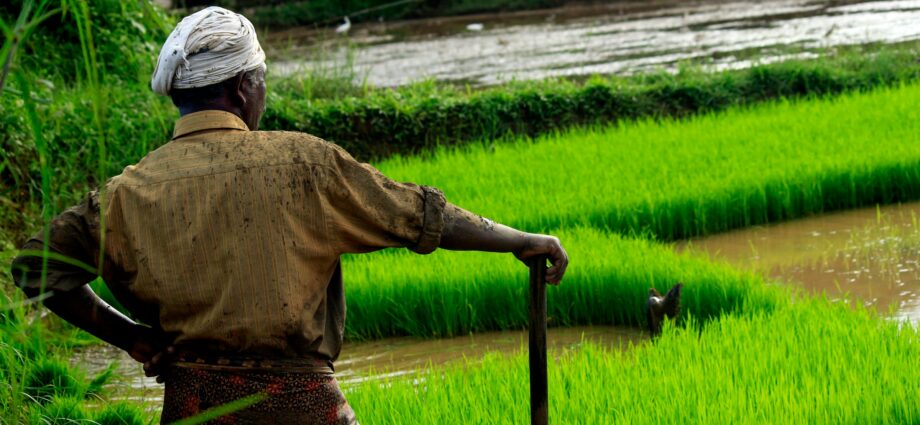
Irrigation facilities in several Indian states are inadequate increasing the dependence of farmers on the monsoon rains.
By Biswajit Dhar, Council for Social Development
July 20, 2024
One of the more enduring images from the iconic film from the 1950s, Do Bigha Zameen, was its poster showing the family of a marginal farmer looking anxiously at the sky hoping that rains would save his tiny holding, their only source of livelihood, from being appropriated by the landlord.
Seven decades later, the importance of timely rains remains critical for the survival of the millions of small and marginal farmers in India, especially for those who are dependent on the kharif (summer) crops. Therefore, year-after-year, the progress of the monsoon is watched with much anxiety.
In April, the Indian Meteorological Department (IMD) predicted that in the 2024 southwest monsoon season, rainfall would be 106 percent of the “long period average” of 870mm, based on rainfall data during 1971-2020.
This scenario was based on the assessments made by the World Meteorological Organization in March that the El Nino climate pattern in the Pacific Ocean, which adversely affects, among other things, rainfall in several regions, including South Asia, was at the end of its 2023-24 cycle.
The La Nina climate pattern bringing favourable weather was likely to take effect from July-August.
A more precise reading of the WMO assessment meant that India would experience better rains in the later phase of monsoon.
El Nino effect slow to wear off
However, three months after the WMO’s assessment, it appears the effect of El Nino has been slow to wear off. The onset of the monsoon has been delayed in large parts of the country.
The monsoon usually sets in around June 1 in the southern states and spreads nationwide by the first week of July. This allows farmers to plant the kharif crops, including the most important staple, rice, besides millet, cotton, maize, pulses, soybean and sugarcane.
This year, the monsoon arrived in Kerala two days early, but its progress has slowed resulting in insufficient coverage by mid-June. The delay will impact the planting of the kharif crops.
The latest IMD assessment said that the rainfall over the entire country until June 18 was “64.5 mm which was 20 percent less than its Long Period Average (LPA) of 80.6 mm”.
Except for the southern states, every other region had moderate to high levels of rain deficiency. The worst affected is the northwest region with a 70 percent deficiency, while central India had a shortfall of 31 percent.
Dryness and heat are worrying signs
These regions were not only extremely low on precipitation, but they also suffered from extreme heatwaves, making conditions worse for farmers to begin planting once the rains arrive.
These are worrying signs for the agricultural sector.
The states most affected by deficient rains account for more than a quarter of the total rice production in India and are also major producers of millet, soybean, sugarcane and pulses.
The prospects of rainfall for the entire month of June are somewhat better with the IMD predicting an eight percent shortfall as compared to the “long period average” and this may not have a serious impact on the levels of production of the major crops.
Even if the monsoon continues to play truant, adversely affecting the production of rice, two developments may help the government tide over short-term domestic rice supply constraints.
First, the Food Corporation of India currently holds 50 million tonnes (MT) of rice, nearly four-fold higher than the buffer of 13.5 million tonnes for July 1.
Second, the government had banned non-basmati rice exports in July 2023 to prevent domestic supply shortages and to keep prices in check.
However, at the same time, the government allowed limited exports to certain countries to meet their food security needs.
According to data provided by the Department of Commerce, Government of India, this caused rice exports in 2023-24 to fall by nearly 26 percent (6 million tonnes) as compared to a year before.
Indications are that the export ban will continue in the current financial year as well.
Irrigation issues
There’s a good reason why a large section of India’s farmers continues to depend on the monsoon. Irrigation facilities remain significantly inadequate in several states, more than five decades after the Green Revolution was introduced.
In 2019-20, the latest year for which data are available, 65 percent of rice production was under irrigation This figure is deceptive since there were considerable variations among states as regards availability of irrigation facilities.
The largest rice producing state, West Bengal, has 51 percent of area under irrigation, while two other major rice producing states, Chhattisgarh and Odisha have 37 percent and 32 percent respectively.
The NDA government has been popularising the consumption of millet, but the major varieties grown in India, jowar and bajra, are not under widespread irrigation. In 2019-20, only 11 percent of jowar production was under irrigation, while for bajra, it was a little higher at 15 percent.
The deficiency of irrigation in the country is the result of inadequate infrastructure supporting agriculture. This is a consequence of decades of neglect.
For years, agriculture has received progressively smaller share of the country’s overall investment. In the 1950s, agriculture’s share was nearly 25 percent, but four decades later, the share had halved.
After 1991, share of investment in agriculture has consistently remained in single digits. In 2021-22, the latest year for which this figure is available, agriculture’s share was below six percent.
Unless the government shows the political will to prioritise the development of agriculture by ensuring that irrigation facilities, together with adequate drainage are provided, uncertainties of the monsoon will continue to adversely affect the economic well-being of a majority of India’s farmers.
Biswajit Dhar is Distinguished Professor, Council for Social Development, New Delhi.
Subscribe to our newsletter.
Originally published under Creative Commons by 360info™.

